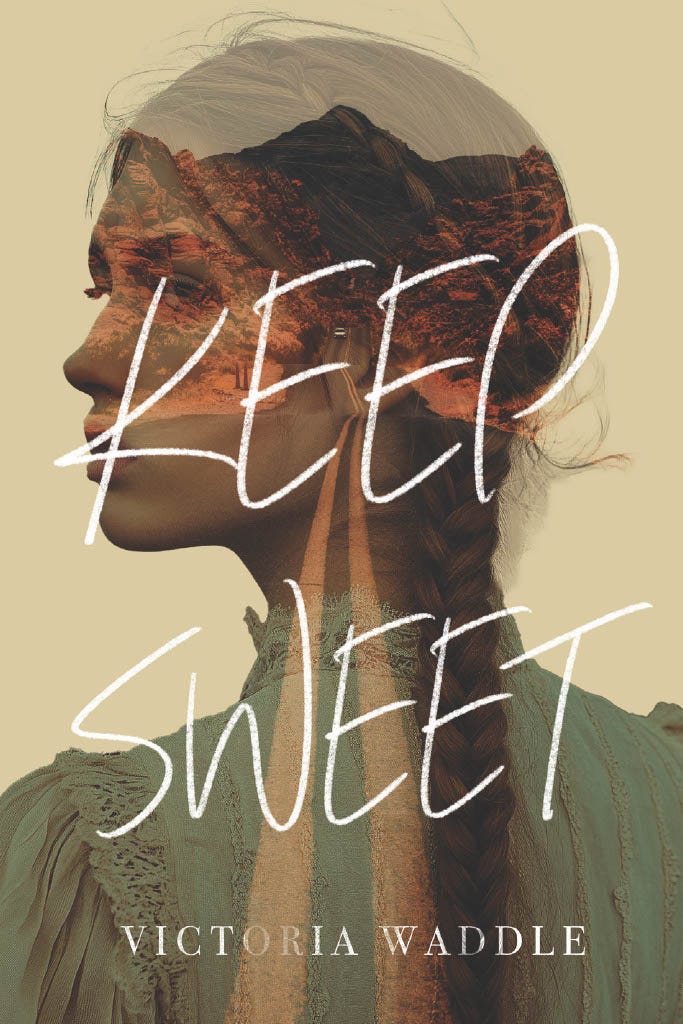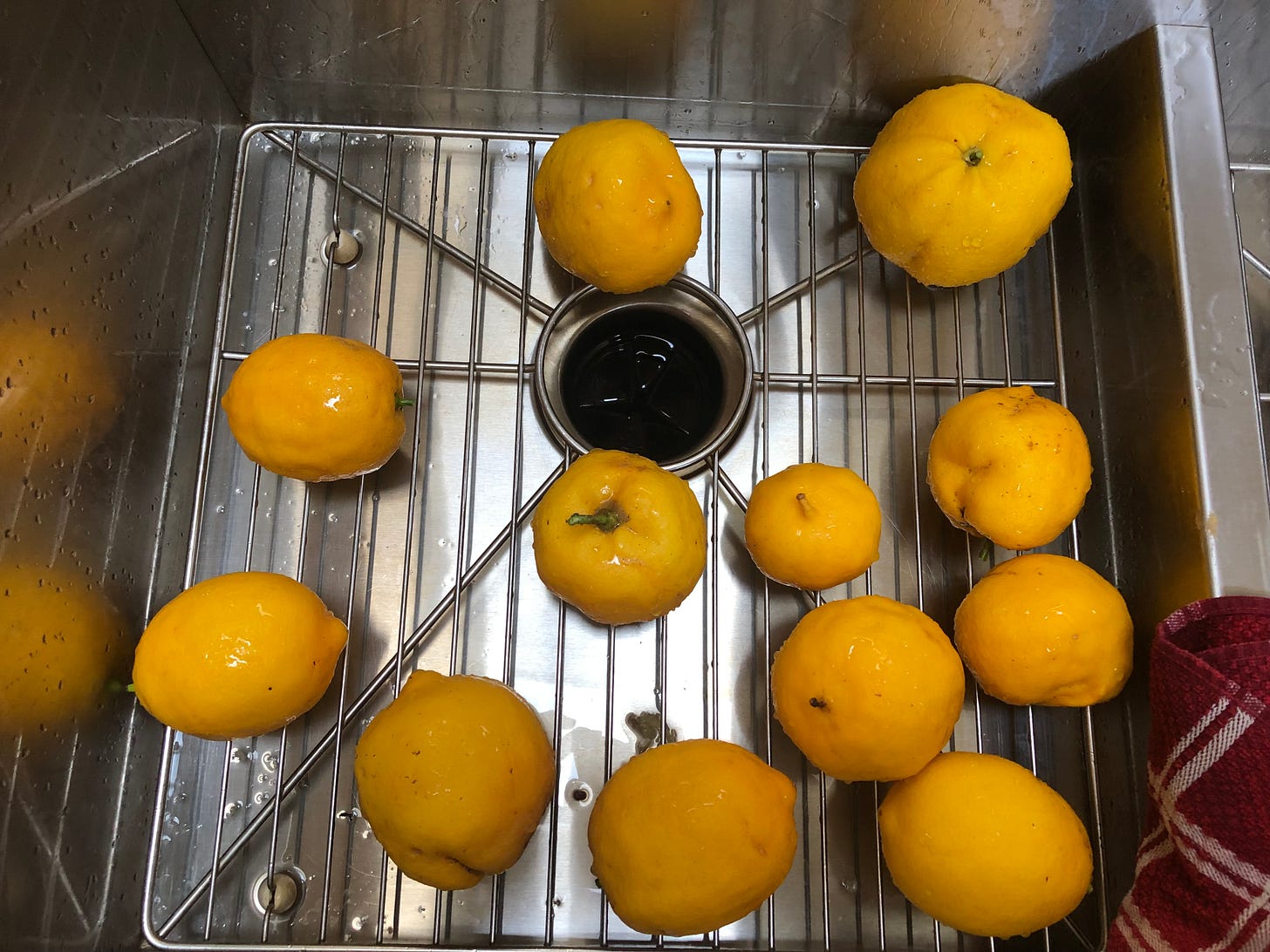Book Review: “Cowboy Apocalypse” and Lemon Recipes
Our dystopian resignation; recipes for lemon olive oil cake and lemon blueberry jam pudding

Hello Friends,
Another tough week. I want to discuss my reading (more recommendations), but if it’s all too much, enjoy the lemon recipes I’ve tried these last few months. And don’t forget:
posts daily about politically actionable things to do in the face of despair (she includes scripts and links to legislators—making it very easy!) as well as a Sunday post on all the good things that have happened during the week. Also, remember Reasons to Be Cheerful. This week they had an article on how bee-keeping enhances the quality of one’s life. One of my sons bee-keeps, so I loved reading that.Recipes!
If you have been with me here for a bit, you know that I have a small lemon tree that produced some lemons this spring/summer and it was my goal to use them all. I am a half-dozen away from meeting that goal. I’ve made lemonade when my kids came over and tried recipes new and old (lemon bars!). Two new recipes that stand out as favorites are both from the NYTimes cooking section. Here are gift links:
One-Bowl Lemon and Olive Oil Cake
This one also has almond flour and nutmeg, plus five eggs for the single layer (I know!), all of which give it a creamy texture and a fruity, nutty flavor. I made eight of these. Birthdays, visits to friends. Delicious!
Baked Lemon Pudding With Blueberry Jam (confession: I used raspberry jam because I like it better)
When one of my sons made a chocolate birthday cake for another to celebrate at their workplace, I decided we could go off script at home with lemon pudding. This is tangy and sweet, has a thin crust on top and is full of creamy goodness. It was a hit.
Book Recommendations
The Prime of Miss Jean Brodie by Muriel Spark
I often try to squeeze in classic books in audio form, titles I’ve always wanted to read but haven’t found the time to. Recently, that novel has been The Prime of Miss Jean Brodie. I thought it was about a young teacher’s sexual awakening, but it’s a lot about the awakening of sexuality and insight of her students. (And, she’s a fascist. Different from what I imagined. . .) Since it’s a classic, I don’t need to discuss it here, but will say that I enjoyed it and recommend it. Short and pointed.
Cowboy Apocalypse: Religion and the Myth of the Vigilante Messiah by Rachel Wagner: An effort to understand why guns matter so much in the United States.
Another thing I’ve been working on is reading books that will help me understand the U.S. today and how we got here. Here’s the latest:
While author Rachel Wagner states that there are many reasons for a person to own a gun, our American obsession with them is dangerous to our community. We have spent decades cultivating the idea that violence will save us from harm—harm being whatever it is we fear—and we’ve role-played that violence until it has become endemic across the nation. In a country of vigilantes, the attack on the capitol on January 6, 2021 appears to be a preordained outcome of this belief system.
It’s strange that the notion that violence will save us has its roots in a nostalgic view of the past, when everything was better. Like all nostalgia, that better past never existed, but it was one that dismissed issues of racial inequality, genocide, women’s rights, climate degradation, immigration, and just about any other significant global concern. You know, America as white people playing baseball and eating apple pie on a summer’s day. An endless Fourth of July. And how do we get back to that imagined past? ‘Burn it all down’ is the apt phrase, but in the U.S. this means, specifically, shoot ‘em up until all the people living outside that summer’s day disappear and those left have the reward of a “purified post-apocalyptic world” (3).
“Nostalgia is longing that neglects lived experience.” (237)
The “good guy with a gun” isn’t interested in saving the world. His goal is to save himself and his family. And he will use that gun, just as cowboys did to ‘win’ the American West, wiping out the ‘savages’ and repurposing the story as one of a man conquering a barren frontier. In fact, simply owning a gun is one way of defining oneself as good and as opposing those who are evil. Wagner contrasts this vigilantism against those national military actions of the past that actually did fight threats, say, against the fascists in World War II.
The cowboy apocalypse is a complete mythic narrative arc. It crafts a story of America’s frontier beginnings, blending it with the imagination of the world’s imminent ending. As I define it, the cowboy apocalypse is a pervasive story expressed in the idiom of armed white men accustomed to being in charge. In this new version of the frontier story, non-white enemies can again be defeated and the wilderness tamed, but only by employing more gun violence. The gun, as a symbol of violent colonization, reflects the continuing force of frontier ideals in a contemporary environment. (2)
“The cowboy apocalypse depends on a self-proclaimed gun-wielding messiah who performs radical salvation with a gun. He doesn’t save the world. He saves his world.” (2)
As Elton John and Bernie Taupin sang, “I’ve seen that movie, too.” Wagner notes that it’s not just movies that celebrate this idea, but also television shows, video games, and novels. But how did we get here?
The two influences on this view of our future are Christian apocalypticism and American frontier mythology, in which indigenous residents were deemed no more than beasts who were cleared out to make room for settler development by cowboys who had to take matters in their own hands. This leads to the ‘good guy with a gun’ trope, a man who can now repeat the wild west narrative.
Ironically, “the cowboy Apocalypse can be viewed as a nationalist retreat, a recursive reference to a violent American past and a dark desire to recreate those conditions. … despite its portrayal of manly force, the cowboy Apocalypse reflects what Robert Alter (1966) has called a ‘failure of nerve, a determination to opt out of the challenges, complexities, and threats of history.’’’ (172)
Wagner includes several chapters discussing how various groups and media have contributed to our retreat from the challenges of the modern world. These influences range widely, from the Ku Klux Klan, the NRA, and doomsday preppers to books and films to first-person shooter games and live action role play (LARPing—and isn’t that what the January 6, 2021 vigilantes were doing?)
“The hankering for apocalypse is a hunger for retribution. But it is also a need for the world-as-story.” (60)
The chapter on apocalyptic religious books interested me because I happen to have read some of them, purely by chance. When I was a pre-teen, a friend bought me The Late Great Planet Earth by Hal Linsey, which sold more than 10 million copies in the 1970s. I did not grow up in an evangelical household and neither did she (both Catholics with big issues, but different issues from apocalyptic thinking). I think she happened to see the book on a display in a bookstore and grabbed it since I liked to read. Being young, I bought Linsey’s vision. All these decades later, I can remember his writing that the locusts in the Book of Revelations were military helicopters. I looked for signs, and believed that Henry Kissinger was the Anti-Christ based on some numerology nonsense in which the letters of his name added up to 666. But, like every apocalypse predicted so far, Linsey’s didn’t come to pass.
A series of books that I had a brief interaction with was the Left Behind series (1994-2007) by Tim LaHaye and Jerry Jenkins, which Wagner describes as “fundamentalist action thrillers” with potboiler plots (67). By the time these were published, this wasn’t anything I wanted to read; but in 1995, I became a high school librarian and students wanted me to order the first in the series. I did, but then had second thoughts. I believed in including all sorts of books in the collection and didn’t want to keep these from students although I thought their vision was pure nonsense. A library collection is not a personal collection (note to Moms for Liberty, et. al.). But these books were excessively, gratuitously violent, weirdly portraying Jesus as the savior through superior firepower, making violence sacred). I felt they were entirely inappropriate for the collection. (Why aren’t conservative book ban folks getting in front of school boards in outrage and reading passages of these books? Just asking.)
I must not have been the only person who found the series inappropriate for teens. In 1998, the author started publishing Left Behind: The Kids, a YA version of a post-apocalyptic world. I bought those and weeded (recycle bin) the others. In Cowboy Apocalypse, the point Wagner makes is that these sorts of books expressed evangelical anxieties of the time, but also expected God to intervene against evil. Today’s ‘dooms-dayers’ seemed to have given up that vision. We are now grounded in a belief that it's every person for themself.
Why, Wagner asks, must that be our national creed?
If the world runs on belief, why not choose beliefs, grounded, and care? Why not craft a vision that is more inclusive and kinder? Belief is not a knee-jerk acknowledgment of what someone else says. If we value human dignity, we can choose to build a world around values of care.
This kind of constructive storytelling isn’t typically performed by governments or political movements. It’s enacted by real impassioned people as they live toward the future they want. (237)
She concludes:
Nostalgia is longing that neglects lived experience. Instead, it depends on an imagined past. If only we could live the way we used to. If only there were just one story to tell. If only we could be at ease. We are experiencing a white apocalypse, an end to the world as white people in America have known it. The shit has hit the fan, and those of us who are white cannot continue unchallenged for theft, indifference, greed, and harm. But what follows the-world-as-we-know-it need not be a barren, bullet-ridden wasteland. What would it mean to survive together with those we have heretofore ignored? What besides the imagination of a gun-driven paroxysm is possible? (237)
She then lays out several possible futures, all far better than the cowboy apocalypse we are trending toward. And this is heartening. We will succeed in a bright future if we have the will to do so.
Cowboy Apocalypse is a worthy read that includes an impressive bibliography and a useful index.







It's encouraging to read this review of a book that ends on a positive note of an imagined better, and more peaceful future. Plus, I'm a sucker for books with great bibliographies, sometimes those are as interesting as what I'm reading